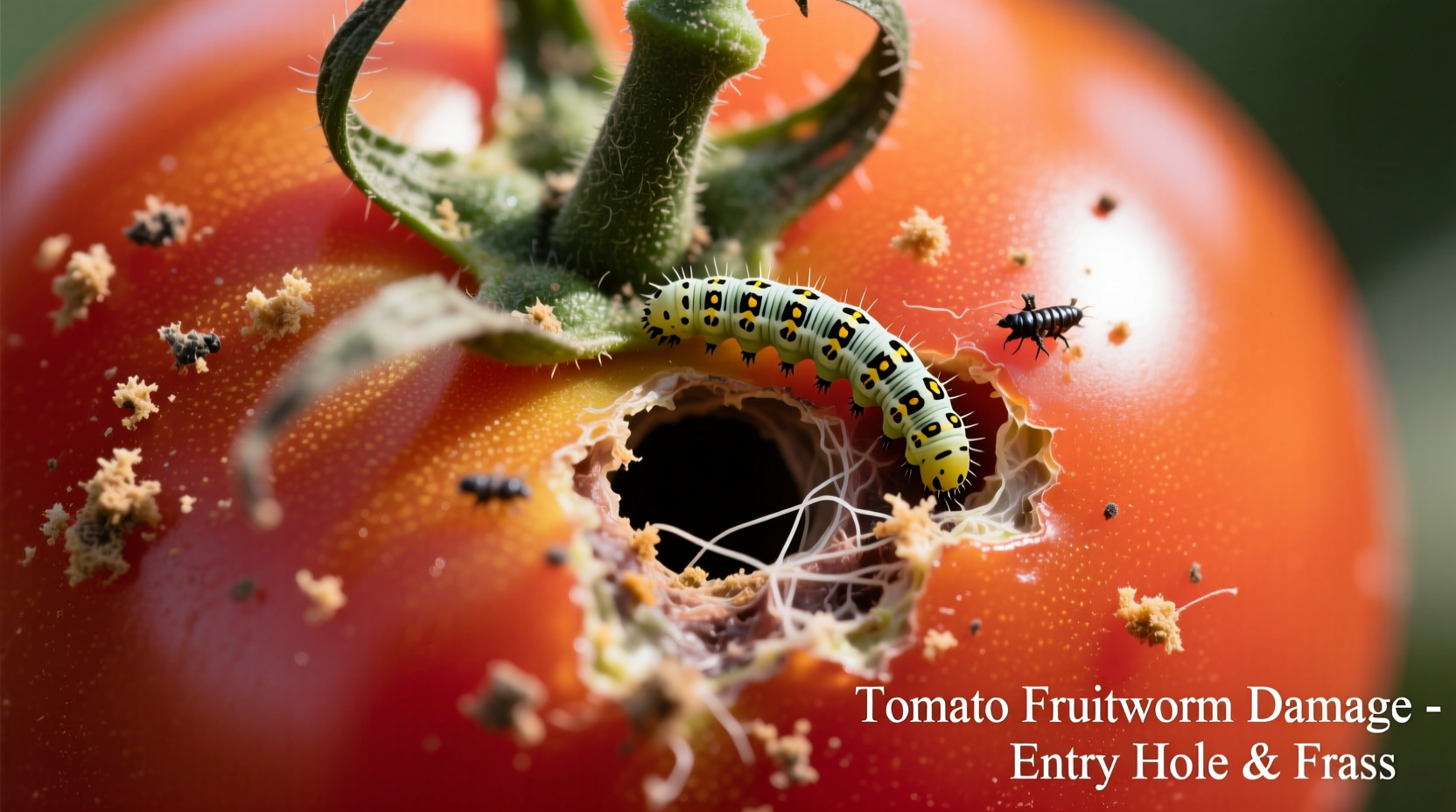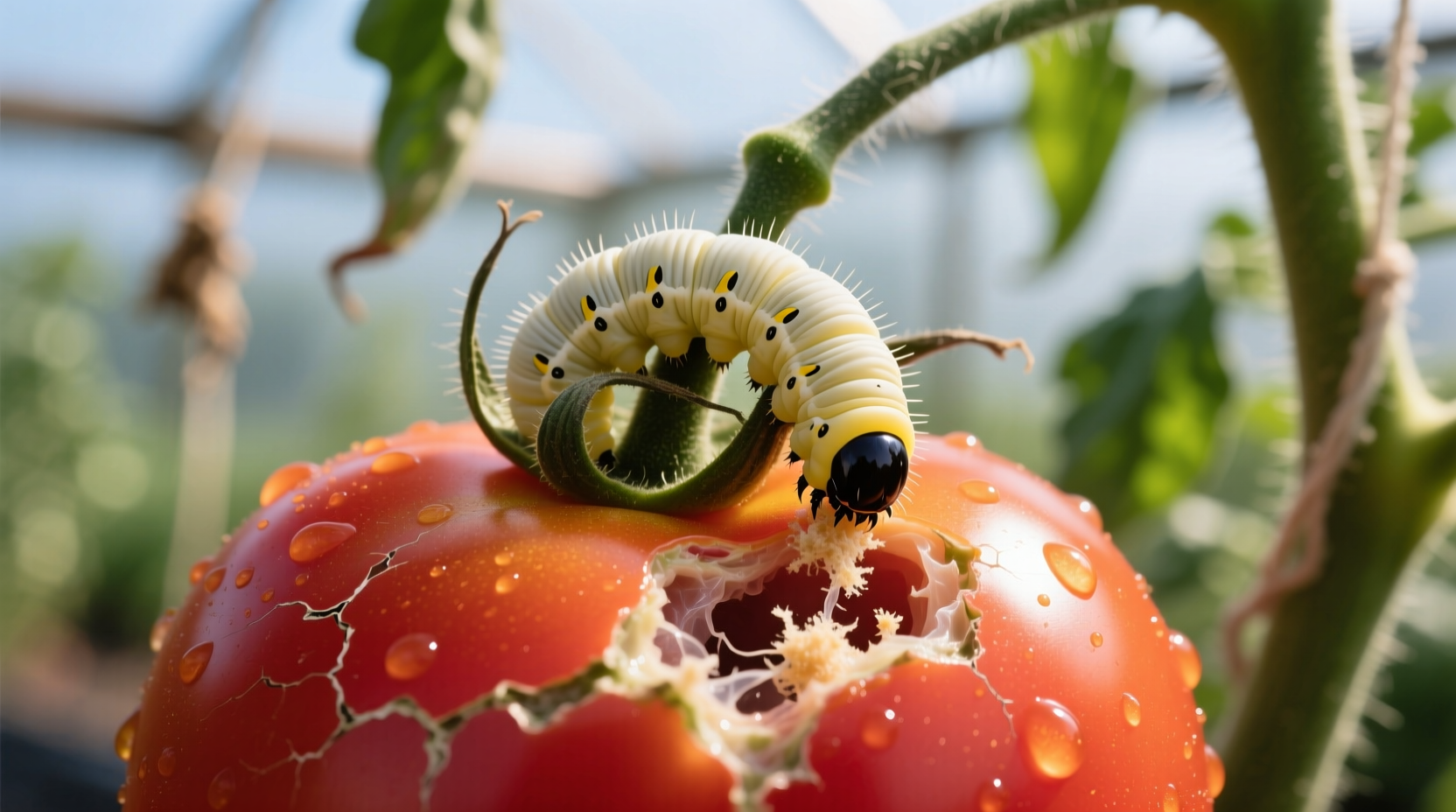Tomato fruitworms (Helicoverpa zea) are destructive caterpillars that burrow into tomatoes, causing rotten spots and premature fruit drop. Immediate identification involves spotting small entry holes with frass (excrement) near tomato stems. Hand-picking larvae at dusk or dawn and applying Bacillus thuringiensis (Bt) are the most effective organic control methods for home gardeners.
Spot the Culprit: Tomato Fruitworm Identification Made Simple
When you notice unexplained holes in your tomatoes with dark excrement trails, you're likely dealing with tomato fruitworms. These pests start as tiny eggs on leaf undersides, hatching into pale green caterpillars that quickly develop distinctive stripes and spots as they mature. Unlike tomato hornworms with their prominent "horns," fruitworms have spiky, variable-colored bodies ranging from green to brown with alternating light and dark stripes.
| Pest Type | Key Identification Features | Primary Damage Pattern |
|---|---|---|
| Tomato Fruitworm | 1-1.5 inch caterpillar with spiky texture, variable coloration (green/brown), alternating stripes | Burrows into fruit near stem, leaves frass at entry point, causes internal rot |
| Tomato Hornworm | 3-4 inch smooth caterpillar with white V-shaped markings, prominent horn on rear | Eats leaves and stems, occasionally nibbles fruit surfaces but rarely burrows inside |
| Tomato Pinworm | Small (0.25 inch) yellow to purple caterpillar with dark head | Mines leaves creating blotch patterns, tunnels shallowly in fruit skin |
Understanding the Threat: Life Cycle and Damage Timeline
Tomato fruitworms follow a predictable seasonal pattern that determines your best intervention windows. According to the University of California Integrated Pest Management Program, their life cycle progresses through these critical stages:
- Egg stage (3-5 days): Tiny, spherical eggs laid singly on leaf undersides
- Larval stage (14-21 days): Five growth phases where damage occurs; later instars burrow into fruit
- Pupal stage (10-16 days): Soil-dwelling resting phase between generations
- Adult moth stage (7-10 days): Nocturnal moths lay 500-3000 eggs per female
Multiple generations occur annually, with peak damage typically appearing in mid-summer. The USDA Agricultural Research Service notes that a single fruitworm can destroy multiple tomatoes during its larval stage, making early detection crucial for crop preservation.
Immediate Action Plan: What to Do Today
If you've confirmed a fruitworm infestation, implement these steps within 24 hours for maximum effectiveness:
- Manual removal: Check plants at dawn/dusk with a flashlight; larvae are most active during these periods
- Biological control: Apply Bacillus thuringiensis (Bt) spray in late afternoon when UV exposure is minimal
- Physical barrier: Install floating row covers immediately after transplanting seedlings
- Pruning protocol: Remove and destroy infested fruit (do not compost) to prevent lifecycle continuation

Prevention Strategies for Next Season
Successful fruitworm management requires planning beyond immediate treatment. The Cornell University Cooperative Extension recommends these evidence-based prevention methods:
- Companion planting: Grow borage, marigolds, or basil near tomatoes to repel adult moths
- Trap cropping: Plant preferred hosts like geraniums at field edges to draw pests away from tomatoes
- Soil management: Till soil in fall to expose pupae to predators and weather elements
- Monitoring system: Install pheromone traps to detect adult moth activity before egg-laying begins
Remember that fruitworms become resistant to chemical controls when overused. The National Pesticide Information Center advises rotating between different control methods to maintain effectiveness throughout the growing season.
When Organic Methods Aren't Enough: Targeted Chemical Options
For severe infestations where organic methods prove insufficient, consider these targeted chemical options with proper safety precautions:
- Spinosad-based products: Effective against young larvae with minimal impact on beneficial insects
- Pyrethrin sprays: Use only as a last resort due to broad-spectrum impact on pollinators
- Neem oil applications: Works as both repellent and growth regulator for early-stage larvae
Always apply chemical controls in the evening after pollinators have left the plants, and strictly follow label instructions regarding harvest intervals. The Environmental Protection Agency emphasizes that proper application timing significantly reduces environmental impact while maintaining effectiveness.
Building Long-Term Resilience in Your Garden
Sustainable fruitworm management focuses on ecosystem balance rather than complete eradication. Research from the Rodale Institute shows gardens with diverse plant species experience 30-50% less pest damage than monoculture plantings. Implement these strategies for lasting protection:
- Attract natural predators by planting dill, fennel, and yarrow to support parasitic wasps
- Maintain healthy soil with compost to strengthen plant natural defenses
- Practice crop rotation with non-host plants like beans or peas between tomato seasons
- Use reflective mulch to disorient adult moths searching for host plants
Understanding the context boundaries of each method ensures you apply the right solution at the right time. For example, Bt works only on young larvae and must be reapplied after rain, while pheromone traps are most effective during specific temperature ranges (65-85°F).
How can I distinguish tomato fruitworm damage from other pests?
Fruitworm damage shows as small entry holes near the stem with dark frass (excrement) visible at the opening. Unlike hornworms that eat leaves, fruitworms burrow directly into the fruit, causing internal rot that makes tomatoes drop prematurely. The entry hole is typically smaller than damage from stink bugs or beetles.
What's the best time of day to find and remove tomato fruitworms?
Tomato fruitworms are most active during dawn and dusk. Conduct inspections with a flashlight during these low-light periods when larvae emerge to feed. They typically hide in leaf clusters or soil during daylight hours, making evening or early morning the optimal time for manual removal.
Can I still eat tomatoes that had minor fruitworm damage?
If you catch the damage early and the worm hasn't penetrated deeply, you can safely cut away at least 1 inch around and below the damaged area. However, if the fruit shows signs of internal rot or mold, or if multiple entry points exist, discard the entire fruit as pathogens may have spread beyond visible damage.
How do I prevent tomato fruitworms from returning next season?
Implement a multi-pronged prevention strategy: rotate tomato planting locations annually, till soil in fall to expose pupae, plant companion crops like basil or marigolds, install pheromone traps to monitor adult activity, and encourage natural predators by maintaining diverse plantings. The University of California IPM program recommends combining at least three prevention methods for best results.











 浙公网安备
33010002000092号
浙公网安备
33010002000092号 浙B2-20120091-4
浙B2-20120091-4